The purpose of this experiment was to discover a homologous behavior shown in Mallard ducks (Anas platyrhynchos) and Humans (Homo sapiens) when stimulated with visual, auditory, and multisensory models. Finding a homologous behavior between two different species is particularly significant as it grants scientists an opportunity to further understand how species have evolved from one another overtime and if they obtain derived traits. It was hypothesized that both humans and Mallard ducks would show increased responsiveness when introduced to a multisensory stimuli compared to solitary auditory or visual stimuli because each modality may convey unique information that elicits certain attention; two modalities would convey larger attention (Hick et al, 2016). To test this hypothesis, a playback experiment was designed with separate trials that each consisted of a visual-only stimuli, an audio-only stimuli, a simultaneous visual and auditory stimuli, and background noise (control group). The collected data resulted in increased response rates to the multisensory cue in both Mallard ducks and Humans, which supported the initial hypothesis and verified a homologous behavior. After this conclusion was made, PCR and gel electrophoresis were completed with human DNA to test if humans possessed DRD4, a cognition gene used which affects attentiveness. The test showed that humans do possess the gene and pointed out where the base pairs were located. Based on the experimental results, it is predicted that ducks would also possess the DRD4 gene which could act as further evidence that the homologous behavior is from derived traits.
Final Author: B-468
Animals have complex communication signals composed of multiple modalities (acoustic, chemical, viational, touch, visual, etc.) that they use to communicate information of potential predation, prey, courtship, and other environmental determinants (Utez et al, 2017). However, current literature has suggested that different species may rely on different modalities more than others (Fulkerson et al, 2014). When Mallard ducks (Anas platyrhynchos) were stimulated with different modality experiments, they were shown to respond with a greater frequency towards audio playback opposed to a visual or olfactory stimuli (Dessborn et al, 2012). For humans (Homo sapiens), research has pointed towards visual stimuli being capable of overcoming effects of auditory stimuli (Smith et al, 2013). This leads to the question at hand, how would the introduction of a multisensory stimuli, such as simultaneous visual and auditory cues, effect the responsiveness of each species? It was hypothesized that both humans and Mallards would show an increase in responsiveness when introduced with a multisensory stimuli compared to single modalities such as auditory-only or visual-only stimuli, because separate modalites may convey unique information that elicits specific attention. (Hick et al, 2016) (Hoy et al, 2005). If the Mallards and humans have similar response patterns when introduced to different types of stimuli, it is predicted that they could share a similar gene that affects their ability to focus, maintain attention, and respond. The DRD4 gene is dopamine receptor that contributes to cognitive function and could be responsible for the homologous behavior if it is shared between the two species. (Gorlick et al 2015).
The Mallard duck (Anas platyrhynchos) is the most abundant species of water-fowl in North America (Johnson et al, 1987). Mallards are one of the few water-fowls which happen to succeed in harsh and varying habitats, which allows them to last year-round (Johnson et al, 1987). This is likely a result of successful intraspecific information transfer similar to that seen in humans (Zimmer et al, 2011). By using different modalities, both humans and Mallards are able to relay these complex signals to members of their own species and further improve their perception of the outside environment. (Bird and Emery 2008). But during communication transfer, neither humans nor animals limit themselves to the use of a single sensory at a time (Colonius et al, 2017). Most animals tend to use multiple-sensory channels simultaneously, in a process known as multisensory or multimodal communication (Partan et al, 2008). Multimodal experiments are highly valued in the science field because it has the ability to stimulate different areas of the brain (Colonius et al, 2017).
In order to investigate the hypothesis, a visual stimulus and a series of multiple playback experiments were presented to both ducks and humans in an attempt to elicit the greatest number of total responses. Three separate trials of three separate treatments were tested on each species. The first treatment involved the use of a single visual stimuli in the form of a human mannequin or a resin duck replica (Smith et al, 1964). The second treatment consisted of an auditory-only playback which projected general duck and human chatter towards the species of study (Brudzynski et al, 1995). The final treatment examined the effects of using both an auditory and visual stimuli, by having the audio playback come directly from the visual model itself (Partan et al, 2009). The responses from each species were measured by observing the amount of vocalizations, head turns, extended staring, motion towards, or motion away from each model (Partan et al, 2009). For treatments which only tested single modalities, such as the visual-only and audio-only, it was predicted that both humans and ducks would respond, but at a low rate because natural social communication in animals involves the use of more than one modality. (Parten et al, 2009). For the treatment which involved using both a playback device and a visual stimuli, it was predicted to give enhanced responsiveness in both Mallard ducks and humans because multiple sensory channels may encode for unique information and increased attention therefore resulting in an increased likelihood of eliciting a response (Hick et al, 2016). These same predictions were expected in every response category (staring, directional movement, etc.) because both species are expected to cognitively place the auditory and visual cues together to try and perceive the information they are being presented with (Uetz et al, 2013).
We predict that both Mallard ducks and Human subjects will react similarly by portraying more behavioral responses when presented with the multisensory stimuli because two different modalities heighten attention (Hick et al, 2012). Although ducks and humans do not share many physical similarities, they both express the enzyme Acetylcholine (ACh), which has been seen to play a vital role in cognitive functions, including attention, learning and memory (Bartus et al, 1982). This enzyme helps regulate the production of the DRD4 dopamine receptor (Markett et al, 2013). If both organisms obtain this enzyme, it is predicted that they will both obtain the DRD4 gene as well. Experimentally, it is assumed that ducks and humans won't generate the exact same amount of responses. However, it is predicted that both will exhibit the same general trends of organisms responding to artificial cues (Hick et al, 2016). If both the Mallard duck species and the Humans showcase similar behaviors to the exposed stimuli, then it is possible that they both encompass the DRD4 gene which plays a vital role in increased response rates due to cognitive behavior of attention (Gorlick et al, 2015).
Final Author: B-777
Testing Ducks with Solitary Audio and Visual Cues
A playback experiment was performed to identify different responses and attention elicited by mallard ducks and humans when exposed to a visual and auditory stimulus. A realistic, artificial Mallard Duck and a small VicTsing SoundHot c6 portable waterproof bluetooth speaker was purchased from Amazon. Mallard Duck chatting noises were obtained from a 30 second Youtube video and played through the bluetooth speaker. The responses of the Mallard ducks were video recorded using the camera on an iPhone XR. The first part of the experiment consisted of placing the artificial duck on a rock by itself in the Red Cedar River within a 2 meter radius of where the majority of the Mallard Ducks congregated (Balsby et al, 2002). The ducks' responses (both male and female) were videotaped for a period of five minutes. This trial served as the solitary visual cue (Smith et al, 1964). Next, the artificial duck was removed from the rock and and replaced with a waterproof speaker which played duck chatter playbacks. The speaker was covered with leaves in order to appear as natural as possible to avoid possible confounding variables. The mallard duck playbacks were played in 30 second intervals along a five minute timespan on the same day, and the different types of responses that the ducks would have made in correspondence to the stimulus were recorded again using the camera on the iPhone XR (Brudzynski et al, 1995).
Testing Ducks With Simultaneous Cues and Control
The observational study also included the aspect of implementing both the visual and auditory parameters simultaneously to act as an additional stimulus. The concurrent visual and auditory cues were introduced into the duck environment, and the different responses made were once again video recorded using an iPhone XR camera. The fourth type of cue presented to the ducks was the concealed speaker playing nature sounds obtained from youtube. This served as the negative control because no response was expected from this cue. The responses of the Mallard ducks were categorized into five groups from the playback experiments: vocalization (responding back to the model), a quick head turn, staring at the model for an extended period of time, walking towards the model, and walking away from the model (Partan et al, 2009). This procedure was repeated on three separate occasions (total of three trials) in order to yield precise results. The amount of specific responses to each type of cue was video recorded and written down. The totals were then averaged among the three trials.
Human Testing
Once the duck population was studied, the next aspect of the study focused on trying to find a homologous behavior exhibited by humans (Homo sapiens). To find this behavior, a similar method was used from that of the mallard duck experiment. The process took place on the campus of Michigan State University, on the river trail behind Wells Hall. The specific area for testing was directly in front of the entrance of the bridge, 100 meters east of the Red Cedar waterfall. Members of the research team stood approximately 10m away from the artificial cues in a neutral area out of sight from potential pedestrians walking by. The tests were split into 4 different experimental variables, audio only playback, visual only model, audio and visual stimuli, and a background noise for a negative control. The first method of testing began by observing human behavior when only a bluetooth speaker was used. The speaker was camouflaged using leaves, outside of plain view from the nearby pedestrians. The second method of testing was the visual only experiment, which consisted of dressing a replica model and disguising it to look like a regular human. The human model obtained from Halloween City was clothed in pants, shoes, and a hoodie with the hood up so the figurine’s face would not be exposed. It was able to stand on its own two feet to increase the similarity to an actual human (Hick et al, 2016). Next, both the audio speaker and visual model were used to determine responsiveness when the organism being studied was given multiple stimuli. This happened to be a similar process as the previous tests as it incorporated methods from each. A bluetooth speaker was then attached to the mannequin to imitate possible sounds that a normal person would make. One phone was directly connected to that speaker through bluetooth and another phone was used to call the cellular device connected to the speaker. For the final test, an audio playback of nature sounds was played over the speaker. The purpose of this was to serve as a negative control and ensure that humans were not just responding to any noise from the speaker.
Audio playback was simulated by connecting a cell phone to the speaker and having one member of the group call out random individuals passing by, asking them questions or making statements which would likely lead to a response. The audio playback was then sent out over the speaker for 30s intervals along a total of a 5 min time span for a series of three different tests (Hick,et al, 2016). The same procedure then took place for the audio-visual playback with the only significant difference being the speaker was attached to the newly placed mannequin (multimodal) (Hoy 2005). The final test involved the human model (only visual, no audio) in which the mannequin was placed in the same area but without any human playback interaction. The responses of the humans were then categorized into the same five groups of that from the Mallard duck playback experiment: vocalization, a quick head turn, staring at the model for an extended period of time, walking towards the model, and walking away from the model. The results for each method and the total responses were collected individually by each group member and the results were averaged out (Hick et al, 2016).
PCR and Gel Electrophoresis
Once field tests were completed, PCR was run. PCR was prepared by mixing 1uL of forward primer, 5'-CTC AGG TCC TTC TGC GTC TGG-3'', 1uL of the reverse primer, 5'-GGCTCACCTCGGAGTAGACGAA-3', 10uL of human DNA sample obtained through cheek swabs, 1uL of free nucleotides, 5uL of 10x PCR buffer, 2uL of Magnesium Chloride, and 29uL of DI water (Beaver et al 2007). Then, 1uL of taq polymerase was added to the PCR mixture last and this PCR solution was run in a thermocycler. The cycle conditions were 95 degrees Celsius for 10 minutes, 40 cycles of 94.5 degrees Celsius for 20 seconds, 61 degrees Celsius for 5 seconds, 72 degrees Celsius for 1 minute and 45 seconds, 72 degrees Celsius for 7 minutes and lastly 12 degrees Celsius for a prolonged period of time to cool the mixture (Mitsuyasu et al, 1999). These cycles were run in a Perkin Elmer 2400 Thermocycler . While the PCR ran in the thermocycler the gel for gel electrophoresis was prepared. This gel was prepared by mixing 47.5 mL of DI water, 0.5g agarose powder, and 2.5 mL of 20x Lithium Borate in a beaker. The beaker was heated for approximately 30 seconds in the microwave in 10 second intervals where the solution was swirled, and then immediately cooled. Once the solution had reached room temperature, 5uL of SYBR safe dye was added, and the mixture was poured in a gel casting tray and refrigerated for 30 minutes. As soon as the gel solidified, the 10uL of Gold Bio 100bp ladder was added to the gel's first well. Then once PCR was ready, 20uL of PCR was mixed with 10uL of dye. After mixing, 10uL of mixture was added to the gel's second well and 10uL was added to the third well. Then, the gel was loaded onto a power source filled with a buffer bath of 1x Lithium Borate with the wells on the negative end. The power source was then turned on allowing a current to move through the buffer pulling the DNA through the gel. This gel was run for about 20 minutes and then the gel was analyzed under a UV light (Lee et al, 2012).
Final Author: B-809
Testing Ducks and Humans with Audio, Visual, and Multisensory Cues
The average number of responses elicited by Mallard ducks to different stimuli were quantified and recorded on three separate trials. The ducks were exposed to the simultaneous cues, where an increased response rate was shown (Figure 1B). The multisensory stimulus elicited the most response with an average of 5 head turns, 1 vocalization, 2 moving away from stimuli, 6 moving toward stimuli, and 11 prolonged staring at stimuli (rounded to the nearest whole number). To account for uncertainty, standard error bars were added, and a Chi-Squared Test was used to statistically analyze the data to compare the treatment types. A p-value of p=0.1508 was calculated, and since it was greater than 0.05, there is no statistical significance to correlate the response type to the stimuli.
The different sensory stimuli were also introduced to human subjects to observe their response rates and types. The humans tended to respond with the highest overall frequency to the multisensory playback with an average of 26 head turns and 26 extensive stares per 5-minute intervals (Figure 2A). Head-turning and extensive staring were the most commonly observed behaviors for all modes of playback. The negative control (background noise) produced no results (Figure 2A). The standard error of the averaged data between the trials was calculated to generate error bars. Additionally, a statistical test was run in the form of a Chi-Squared test which produced a p-value of p=0.175, pointing to statistical insignificance within the data due to the value being less than 0.05.
Collective comparison of responses of Humans and Mallard Ducks
The simultaneous stimuli evoked the highest number of total responses of the observed Mallard ducks and humans. Over the three trials, the Mallards had an average of 25 total responses (Figure 3A), and humans had an average of 60 responses to simultaneous cues (Figure 3B). An ANOVA test was conducted to determine statistical significance, which produced values of F= 4.040 p = 0.018 for ducks and F= 1.4 p= 0.27 for humans. The values for the ducks indicate that averages between stimuli are significantly different, however, values are insignificant for humans, since the p-value was greater than 0.05, which can be attributed to an error in sample size or recording errors due to hectic movement. Additionally, error bars were implemented onto the bar graph to represent the standard error.
PCR and Gel electrophoresis for Human DRD4 dopamine receptor gene
PCR and gel electrophoresis tests were conducted using human cheek cells to confirm the DRD4 gene presence. The 1.5% agarose gel indicated that in Wells A and B, the base pairs did not line up with the Gold Bio 100 base pair ladder (Figure 4A). The presence of the forward and backward primers was displayed instead of the 764 bp DNA target segment. If PCR were to have been successful, the white band indicated in Well A would have been located around the 764 bp length region. The Paint application was used to determine the molecular distance traveled (Pixels) by the DNA, which corresponded to the base pairs present in the genomic ladder. These values were plotted on the graph which generated a logarithmic curve, where the y-axis was scaled to produce a linear trendline with an equation of y=14840e-0.02x(Figure 4B). The pixels of bands in Wells A and B were input into the equation to generate values of 43.17bp and 45.84bp, respectively, indicating the lengths of the primers. Additionally, the well between the ladder and well B was voided from the results due to the possibility of error during methodology, and the large cloud near the top of the gel was attributed to an erroneous gel preparation.
Final Author: B-468
Balsby, Thorsten J.s., and Torben Dabelsteen. Female Behaviour Affects Male Courtship in Whitethroats, Sylvia Communis: an Interactive Experiment Using Visual and Acoustic Cues. Animal Behaviour, vol. 63, no. 2, 2002, pp. 251-257., doi:10.1006/anbe.2001.1920.
Bates BT, Dufek JS, Davis HP Med Sci Sports Exerc. 1992 Sep; 24(9):1059-65.
Beaver, K. M., Wright, J. P., DeLisi, M., Walsh, A., Vaughn, M. G., Boisvert, D., & Vaske, J. (2007). A gene x gene interaction between DRD2 and DRD4 is associated with conduct disorder and antisocial behavior in males. Behavioral and brain functions : BBF, 3, 30. doi:10.1186/1744-9081-3-30
Bird, Christopher D., and Nathan J. Emery. Using Video Playback to Investigate the Social Preferences of Rooks, Corvus Frugilegus. Animal Behaviour, vol. 76, no. 3, 2008, pp. 679-687., doi:10.1016/j.anbehav.2008.04.014.
Brudzynski, Stefan M., and Eva M.c. Chiu. Behavioural Responses of Laboratory Rats to Playback of 22 KHz Ultrasonic Calls. Physiology & Behavior, vol. 57, no. 6, 1995, pp. 1039-1044., doi:10.1016/0031-9384(95)00003-2.
Dessborn, Lisa, et al. "Innate Responses of Mallard Ducklings towards Aerial, Aquatic and Terrestrial Predators." Behaviour, vol. 149, no. 13/14, 2012, pp. 1299-1317., www.jstor.org/stable/41720616.
Fulkerson, Matthew. Rethinking the senses and their interactions: the case for sensory pluralism. Frontiers in psychology vol. 5 1426. 10 Dec. 2014, doi:10.3389/fpsyg.2014.01426
Gonzalez-Giraldo, Y., Trujillo, M. L., & Forero, D. A. (2017, November 16). Retrieved from https://www.tandfonline.com/doi/pdf/10.1080/13813455.2017.1401643
Gough, N. R. (2018, February 15). Acetylcholinesterase & Cholinergic Signaling in Development. Retrieved from https://www.bioserendipity.com/beyond-neurons-guts-and-bones-need-acetylcholinesterase-and-cholinergic-signaling-to-develop/
Gorlick, M. A., Worthy, D. A., Knopik, V. S., McGeary, J. E., Beevers, C. G., & Maddox, W. T. (2015). DRD4 long allele carriers show heightened attention to high-priority items relative to low-priority items. Journal of cognitive neuroscience, 27(3), 509-521. doi:10.1162/jocn_a_00724
Hick, Kristina G., Stephanie M. Doucet, and Daniel J. Mennill. "Tropical Wrens Rely More on Acoustic Signals than Visual Signals for Inter- and Intraspecific Discrimination." Animal Behaviour, vol. 118, 2016, pp. 153-163.
Hoy, R. (2005, February 15). Animal awareness: The (un)binding of multisensory cues in decision making by animals. Retrieved from https://www.pnas.org/content/102/7/2267
James, C. R., & Herman, J. A. (2007). Number Of Trials Necessary To Achieve Performance Stability During Landing. Medicine & Science in Sports & Exercise, 35(Supplement 1), 126-134. doi: 10.1097/00005768-200305001-01246
Lorenz T. C. (2012). Polymerase chain reaction: basic protocol plus troubleshooting and optimization strategies. Journal of visualized experiments : JoVE, (63), e3998. doi:10.3791/3998
Lee, P. Y., Costumbrado, J., Hsu, C. Y., & Kim, Y. H. (2012). Agarose gel electrophoresis for the separation of DNA fragments. Journal of visualized experiments : JoVE, (62), 3923. doi:10.3791/3923
Markett, S., & Reuter, M. (2013, January). The dopamine D2 receptor gene DRD2 and the nicotinic acetylcholine receptor gene CHRNA4 interact on striatal gray matter volume: Evidence from a genetic imaging study. Retrieved from https://doi.org/10.1016/j.neuroimage.2012.08.059
Mitsuyasu, Hiroshi, et al. "Novel Polymorphisms in the Upstream Region of the Human Dopamine D4 Receptor (DRD4) Gene." Journal of Human Genetics, vol. 44, no. 6, 1999, pp. 416-418., doi:10.1007/s100380050191
Partan, Sarah R., et al. "Wild Tree Squirrels Respond with Multisensory Enhancement to Conspecific Robot Alarm Behaviour." Animal Behaviour, vol. 77, no. 5, 2009, pp. 1127-1135., doi:10.1016/j.anbehav.2008.12.029.
R.T. Bartus, R.L. Dean, B. Beer, A.S. Lippa The cholinergic hypothesis of geriatric memory dysfunction Science, 217 (1982), pp. 408-417
Smith, Elliot, et al. "Seeing Is Believing: Neural Representations of Visual Stimuli in Human Auditory Cortex Correlate with Illusory Auditory Perceptions." PLoS ONE, vol. 8, no. 9, 2013, p. e73148. Gale Academic Onefile, https://link-gale-com-proxy2-cl-msu-edu.proxy1.cl.msu.edu/apps /doc/A478425687/AONE?u=msu_main&sid=AONE&xid=f287f8f6. Accessed 11 Sept. 2019.
Smith, F. V., & Bird, M. W. (2004, December 20). The correlation of responsiveness to visual and auditory stimuli in the domestic chick. Retrieved from https://www.sciencedirect.com/science/article/pii/0003347264900107?via=ihub.
Uetz, George W., et al. "Complex Signals and Comparative Mate Assessment in Wolf Spiders: Results from Multimodal Playback Studies." Animal Behaviour, vol. 134, 2017, pp. 283-299., doi:10.1016/j.anbehav.2017.02.007.
Von Kriegstein K. A Multisensory Perspective on Human Auditory Communication. In: Murray MM, Wallace MT, editors. The Neural Bases of Multisensory Processes. Boca Raton (FL): CRC Press/Taylor & Francis; 2012. Chapter 34. Available from: https://www.ncbi.nlm.nih.gov/books/NBK92846/
Weizmann Institute of Science. 2008. DRD4 Gene (Protein Coding). Gene Cards Suite.
Wilson, John X., and Nigel H. West. "Cardiovascular Responses to Neurohormones in Conscious Chickens and Ducks." General and Comparative Endocrinology, vol. 62, no. 2, 1986, pp. 268-280., doi:10.1016/0016-6480(86)90117-6.
Zimmer, Cedric, et al. Behavioural Adjustment in Response to Increased Predation Risk: A Study in Three Duck Species. PLoS ONE, vol. 6, no. 4, 2011, doi:10.1371/journal.pone.0018977.
Final Author: B-009
![]()

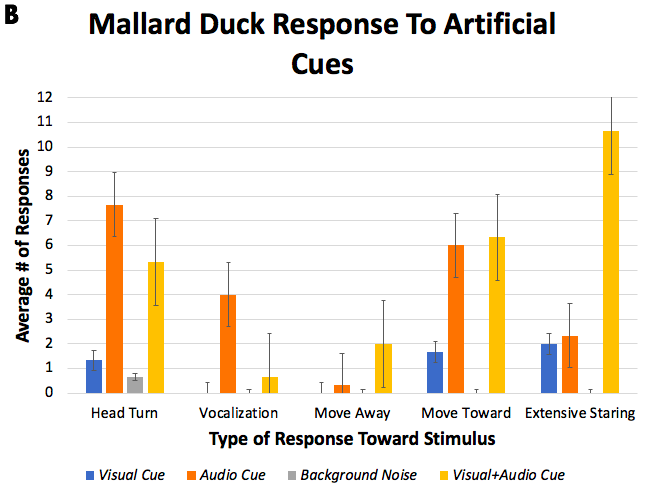
Figure 1: Reactions of Mallard Ducks toward artificial audio and visual cues. (A.) This is a brief gif showing the environment that Mallard Ducks were observed in. The figure shows reactions of the ducks toward a visual and auditory stimulus that was placed on a nearby rock. (B.) This figure displays quantitative data that was collected while observing specific reactions Mallard Ducks had toward artificial stimuli in their environment. The stimuli included an audio cue which was a hidden speaker playing duck chatter, a visual cue which was a plastic Mallard Duck, background noise which was a hidden speaker playing synthetic nature sounds, and a simultaneous audio/visual cue which involved a plastic Mallard Duck with a speaker hidden beside it playing duck chatter. The reactions of the ducks to these different stimuli were recorded and categorized as head turns, vocalizations, moving away from the stimuli, moving toward the stimuli, and extensive staring at the stimuli (Partan et al, 2009). Separate bars were used to represent the different types of responses. The error bars represent standard error. Three trials were done and the average number of responses was recorded (Figure 1B). While conducting a Chi Squared Test of Independence to compare the different types of treatments, a p value of 0.1508 was obtained meaning the result is insignificant at p<.05. This states that there is no significant evidence to correlate the type of response with the type of cue. The average sample size was 19 Mallard Ducks. The simultaneous audio/visual cue elicited the most response with an average of 5.33 head turns, 0.66 vocalizations, 2 ducks moving away from the stimuli, 6.33 ducks moving toward the stimuli, and 10.66 ducks staring at the stimuli for a prolonged period of time. (B-777)
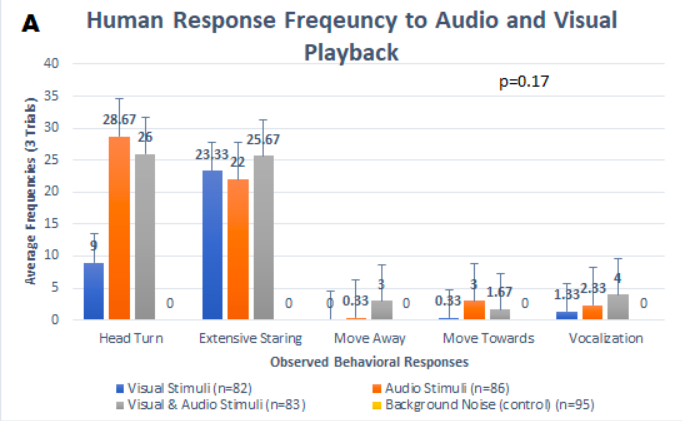
![]()


Figure 2: Results of the average response frequency of 5 observed behaviors in humans (Homo sapiens)
when stimulated with an auditory, visual, or an auditory & visual cue. (A.)
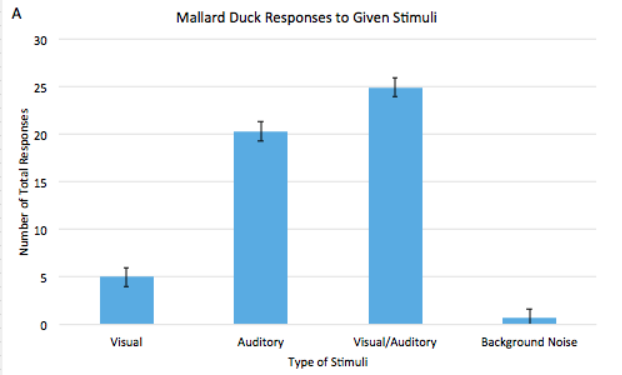
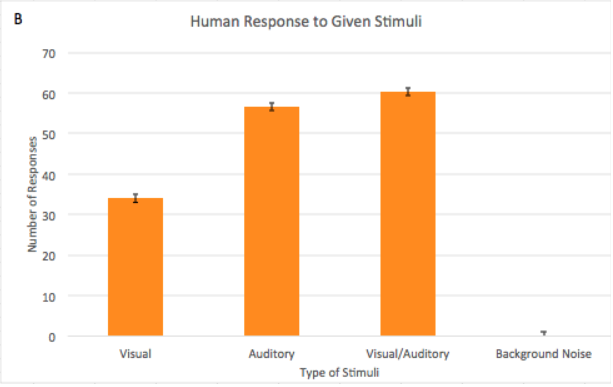
Figure 3: Average total responses from each stimulus - Mallard ducks and humans. Data shows the total
number of responses recorded when each species was presented with different stimuli. Each column is a sum of
responses (head turn, extended stare, movement towards, movement away, vocalization) averaged between 3 experimental
trials. (A.) Mallard duck responses to visual, auditory, visual/auditory, and background noise. Average sample
size across 3 trials n=19. (B.) Human responses to visual, auditory, visual/auditory, and background noise.
Average sample size between 3 trials n= 86.5. Sample sizes varied among trials so n= average. ANOVA test F= 4.040
p = .018 for ducks; F= 1.4 p= .27 for humans. These values show the averages for the duck species between stimuli
is significantly different, but not for the human species. This could be due to measurement error in the large human
population or recording errors due to hectic movement. Overall, the trends on the two graphs are similar and the
multisensory stimuli in both species were higher; this is a homologous behavior. This homologous behavior leads to
the possibility of a shared gene. Error bars represent the standard error. Responses were collected separately from
individual counts; one duck/human can account for multiple responses. (B-009)
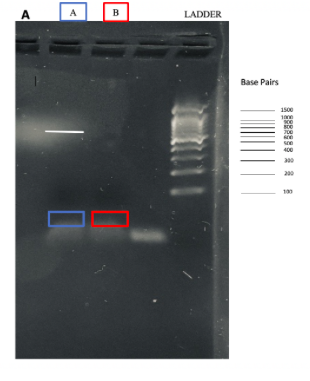
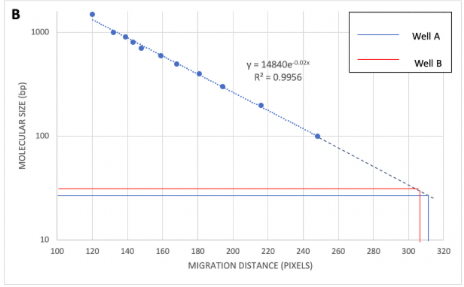
Figure 4: PCR and Gel Electrophoresis test on Dopamine Receptor D4 (DRD4) protein-coding gene to establish gene presence in Humans (homo sapiens). (A.) The agarose gel electrophoresis displayed (Figure 4A) utilizes PCR which uses the forward primer, 5'-CTCAGGTCTTTCTGCGTCTGGC-3', and the backward primer, 5'-GGCTCACCTCGGAGTAGACGAA-3' (Mitsuyasu et al 1999). The first well is comprised of the Gold Bio 100 base pair ladder designed with the 1.5 % agarose gel. Well A and Well B both contain the DNA from human cheek cells. The targeted DRD4 segment for PCR was 764 base pairs (bp), therefore, the bands in Wells A and B should appear at that ladder band, which is indicated by the bright white band in Well A. (B.) The graph displays the 100 bp ladder (molecular weight) on the y-axis, and the x-axis represents the distance the DNA traveled from the wells, in pixels. Pixels were used on the Paint application in order to ensure precision. The y-axis was put into a logarithmic scale and therefore allowed for higher accuracy within results. The equation y=14840e-0.02x will allow in finding the bp of the DNA in the two wells. It was found that the DNA length in Well A and Well B was around 43.17 bp and 45.84, respectively. (B-809)
Figure 5: A film was created to further delve into the topic of finding a homologous communication behavior between
Mallard Ducks and Humans. The whole purpose of this research was to analyze possible relationships between vastly different
species in order to gain a better understanding of evolution and possible ancestral relationships.